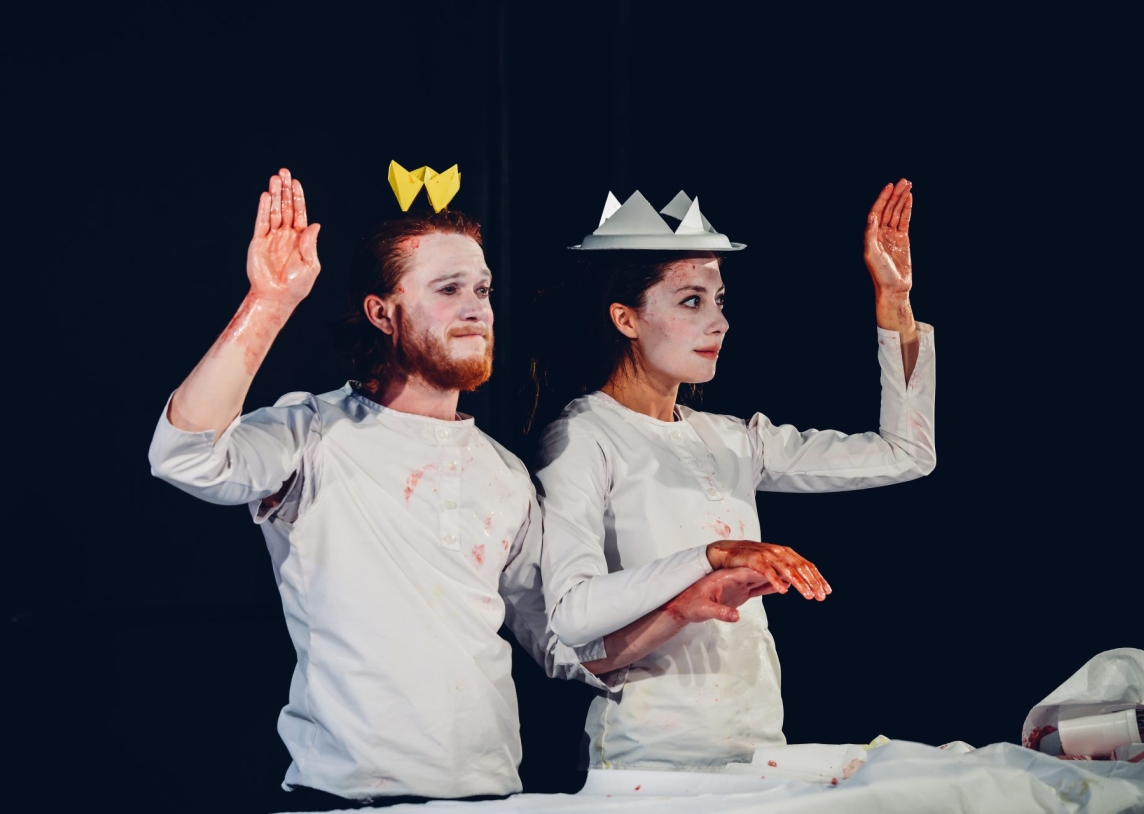- International Platform
- Content
Content
La Fille du Laitier: Macbeth Muet
Author: Tjaša Breznik
The critique was originally published in the newspaper Delo (24.9.2022), with which the platform collaborated during the Lutke Festival 2022.
Eggs, paper plates, kitchen gloves, a playing card with the image of the king of hearts and animation of one's own hand are just some of the many elements of Macbeth Muet (written by Marie-Hélène Bélanger Dumas and Jon Lachlan Stewart, directed by Jon Lachlan Stewart), which takes a completely innovative approach to the issue of bloodshed for the sake of power and authority.
The scenes from Shakespeare's tragedy, announced by the chiming of a bell, are arranged one after the other on stage like meals at a multi-course dinner; this is also the main scenic representation, a long, snow-white dining table (set design by Cédric Lord) in the foreground. Even though heads are falling on it, the action is presented with a childlike exaggeration of movements and expressions familiar from cartoons or silent films. Macbeth Muet is characterised by the tradition of silent cinema (the performance is silent except for the screams and the interludes), which is reflected not only in the movement, but also in the clothes and the white-painted faces of the actors.
An excellent indicator – and at the same time an upgrade – of the chosen framework are the inscriptions written on a roll of paper, which are reminiscent of silent film vignettes and at the same time introduce prologues that further fragment the already highly dynamic and innovative structure (each chiming sound brings a new glimpse, which both demands and evokes the viewer's concentration and attention), as well as inserting the interstories of some of the protagonists (Macbeth, Banquo, and Macduff) in the basic narrative. The final unfolding of events is also explained by the use of inscriptions, this time on black plates, which humorously explain, among other things, that Macbeth is, after all, just a man who has been "fate-fucked".
Macbeth Muet, with its accentuated physicality, innovative approaches and abundance of humour, evokes laughter from the audience, while, with frequent and rapid changes of mood in a choppy rhythm, it skilfully navigates between tragic, touching moments and a light, sometimes even flippant tone, leaving the audience room for a freer interpretation, less tied to the original. Despite its formal boldness, the content is presented in detail, albeit without dramatic speech. The silence of the performance is its great advantage, as it allows for a physical or movement emphasis and focus on the objects mentioned, and a peculiar departure from the – also language-based – tragic nature of the original.
Macbeth Muet also effectively avoids seriousness through the thoughtful design of lighting and sound (sound design by Jon Lachlan Stewart), which jumps from classical pieces to hits, but does not deprive us of reflections on fateful decisions and excessive parvenuism, but—on the contrary—potentiates them.
At times, the musical texts replace or complement the dialogue, which the actors do brilliantly with their facial expressions and gestures, while the tempo often directs their bodies, spontaneously slows them down or stimulates them to even greater effect. It is clear that Clara Prévost and Jérémie Francoeur are extremely skilled performers who change props, many of which become puppets, raise the flag and perform (often literally) breakneck brawls over white sheets smeared with red paint, not only with seeming ease but even with dancing skill.
Even though the play is marked by skipping and cutting scenes, and by lightning-fast changes of contradictory atmospheres, Macbeth Muet creates a complete, coherent and poetic narrative, unfolding Macbeth's fate in all its—tragic and humorous—fullness.
This publication is written in the context of the project "European Contemporary Puppetry Critical Platform"

